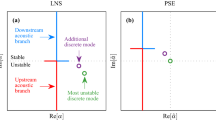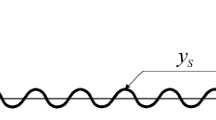Abstract
The recently developed method of parabolized stability equations (PSE) offers a fast and efficient way of analyzing the spatial growth of linear and nonlinear (convective) disturbances in shear layers. For incompressible flows, the governing equations may be represented either in primitive variables or by using other formulations obtained by eliminating the pressure gradient (e.g., vorticity-streamfunction formulation). On the other hand, for compressible flows, primitive variables offer a natural and the only choice. We show that primitive-variable formulation is not well-posed due to the ellipticity introduced by the\(\partial \hat p/\partial x\) term and the marching solution eventually blows up for a sufficiently small step size. However, it is shown that this difficulty can be overcome if the minimum step size is greater than the inverse of the real part of the streamwise wave number, αr. An alternative is to drop the\(\partial \hat p/\partial x\) term, in which case the residual ellipticity is of no consequence for marching computations with much smaller step sizes. However, the ellipticity cannot be completely removed. Results obtained with streamfunction and vorticity-velocity formulations also show that the numerical difficulties arise for a sufficiently small marching step size. This step-size restriction can be overcome by dropping thedα/dx term from the governing equations. The effect of this term on solution accuracy is negligible for Blasius flow but not so for rotating-disk flow.
Similar content being viewed by others
References
Anderson, D.A., Tannehill, J.C., and Pletcher, R.H. (1984),Computational Fluid Mechanics and Heat Transfer, Hemisphere, New York.
Bender, C.M., and Orszag, S.A. (1978),Advanced Mathematical Methods for Scientists and Engineers, McGraw-Hill, New York.
Bertolotti, F.P. (1993), PSE for Incompressible Flows, ICASE/LaRC Short Course on Transition, Newport News, VA, June 1–5.
Bertolotti, F.P., Herbert, Th., and Spalart, P.R. (1992), Linear and nonlinear stability of the Blasius boundary layer,J. Fluid Mech.,242, 441–474.
Carrier, G.F., and Pearson, C.E. (1976),Partial Differential Equations, Theory and Technique, Academic Press, New York.
Chang, C.-L., and Malik, M.R. (1994), Oblique-mode breakdown and secondary instability in supersonic boundary layers,J. Fluid Mech.,273, 323–359.
Chang, C.-L., Malik, M.R., Erlebacher, G., and Hussaini, M.Y. (1991), Compressible Stability of Growing Boundary Layers Using Parabolized Stability Equations, AIAA Paper 91-1636.
Dhanak, M.R. (1992), Effect of suction of the stability of flow on a rotating disk, inInstability, Transition, and Turbulence, M.Y. Hussaini, A. Kumar, and C.L. Streett, eds., Springer-Verlag. New York, pp. 151–167.
Fasel, H.F., and Konzelmann, U. (1990) Non-parallel stability of a flat plate boundary layer using the complete Navier-Stokes equations.J. Fluid Mech.,221, 331–347.
Gaster M (1974), On the effects of boundary layer growth on flow stability,J. Fluid Mech.,66, 465–480.
Golub, G.H., and Van Loan, C.F. (1983),Matrix Computations, Johns Hopkins University Press, Baltimore, MD.
Gregory, N., Stuart, J.T., and Walker, W.S. (1955), On the stability of three-dimensional boundary layers with application to the flow due to a rotating disk,Philos. Trans. Roy. Soc. London Ser. A,248, 155–199.
Haj-Hariri, H. (1994), Characteristics analysis of the parabolized stability equations.Stud. Appl. Math.,92, 41–53.
Hall, P. (1994), A Phase Equation Approach to Boundary Layer Instability Theory, ICASE Report No. 94-23 (NASA CR-194901).
Hall, P., and Smith, F.T. (1989), On Strongly Nonlinear Vortex/Wave Interactions in Boundary-Layer Transition, ICASE Report No. 89-82 (NASA CR-181963).
Herbert, Th. (1991), Boundary-Layer Transition—Analysis and Prediction Revisited, AIAA Paper 91-0737.
Herbert, Th. (1994), Parabolized Stability Equations, AGARD-R-793, p. 4–1.
Joslin, R.D., Streett, C.L., and Chang, C.-L. (1992), 3-D Incompressible Spatial Direct Numerical Simulation Code Validation Study—A Comparison with Linear Stability and Parabolic Stability Equation Theories for Boundary-Layer Transition on a Flat Plate, NASA TP-3205.
Kreiss, H.-O., and Lorenz, J. (1989),Initial-Boundary Value Problems and the Navier-Stokes Equations, Academic Press, New York.
Li, F., and Malik, M.R. (1995), Fundamental and subharmonic secondary instabilities of Görtler vortices,J. Fluid Mech.,297, 77–100.
Malik, M.R., and Balakumar, P. (1992), Nonparallel stability of rotating disk flow using PSE, inInstability, Transition, and Turbulence, M.Y. Hussaini, A. Kumar, and C.L. Streett, eds., Springer-Verlag, New York, pp. 168–180.
Malik, M.R., Chuang, S., and Hussaini, M.Y. (1982), Accurate numerical solution of compressible stability equations,Z. Aagew. Math. Phys.,33, 189–201.
Malik, M.R., Li, F., and Chang, C.-L. (1994), Crossflow disturbances in three-dimensional boundary layers: nonlinear development, wave interaction and secondary instability,J. Fluid Mech.,268, 1–36.
Rubin, S.G. (1981), A review of marching procedures for parabolized Navier-Stokes equations,Proceedings of Symposium on Numerical and Physical Aspects of Aerodynamic Flows, Springer-Verlag, New York, pp. 171–186.
Rubin, S.G., and Tannehill, J.C. (1992), Parabolized/reduced Navier-Stokes computational techniques,Ann. Rev. Fluid Mech.,24, 117–144.
Saric, W.S., and Nayfeh, A.H. (1975), Non-parallel stability of boundary layer flows,Phys. Fluids,18, 945–950.
Smith, F.T. (1979), On the non-parallel flow stability of the Blasius boundary layer,Proc. Roy. Soc. London Ser. A.,366, 91–109.
Smith, F.T., Papageorgiou, D., and Elliott, J.W. (1984), An alternative approach to linear and nonlinear stability calculations at finite Reynolds numbers,J. Fluid Mech.,146, 313–330.
Author information
Authors and Affiliations
Additional information
Communicated by M.Y. Hussaini
This work was performed under AFOSR contract F49620-91-C-0014.
Rights and permissions
About this article
Cite this article
Li, F., Malik, M.R. On the nature of PSE approximation. Theoret. Comput. Fluid Dynamics 8, 253–273 (1996). https://doi.org/10.1007/BF00639695
Received:
Accepted:
Issue Date:
DOI: https://doi.org/10.1007/BF00639695




